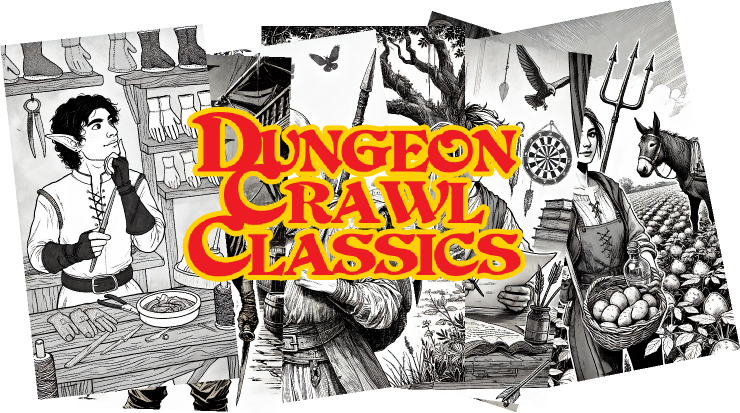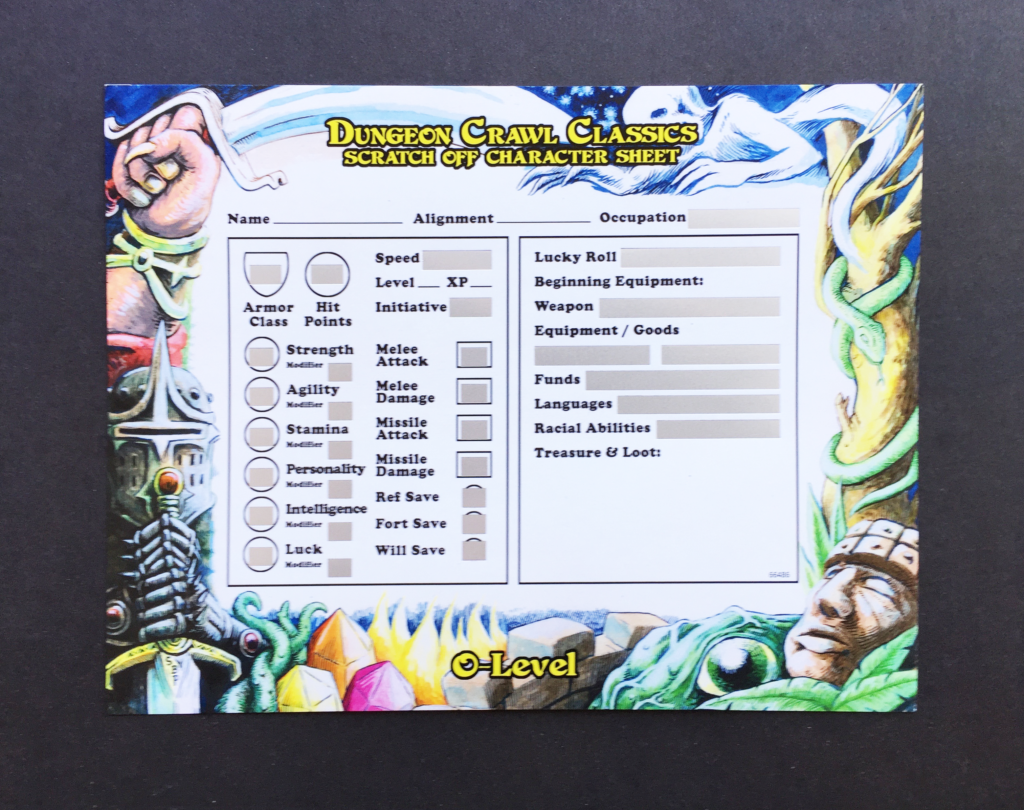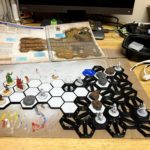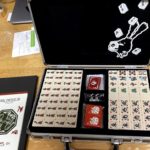The Dungeon Crawl Classics folks really gave me the hard sell at Origins 2024. Gaming like they did it in the 70s. A focus on adventuring over roleplaying. Mixing things up. Don’t care if you live or die, as long as you had fun doing it.
That sounded like fun. Our D&D campaign is winding down, probably only two or three more sessions, and it would be nice to try something fun for awhile.
(Want a PDF of the Getting Started guide? Here it is!)
Creating a character
Creating a character is easy. No choosing spells or skills or race or much of anything. You roll 3D6 for each of the six characteristics, in order — strength, agility, stamina, personality, intelligence and luck. You roll d100 for your occupation, which will give you your race, occupation, starting weapon, and trade goods. You roll d20 for starting equipment, 5d12 for starting copper, 1d4 and your stamina mod for your starting health, d30 for your luck influence, and… done. You have your level 0 character.
It is so automatic, that I wrote a little program to do the rolling:
Once the character reaches level 1, they get to choose a class (unless their occupation has made them a dwarf, elf or halfling, which are both races and classes in DCC). But to reach level 1, they have to survive to level 1. That takes only 10 xp, but in DCC, your typical encounter only gives 2 xp. And there is no healing to full by just resting; you can rest back only one health point per day, but you can lose it a lot faster.
DCCs solution is to have every player roll up from three to five characters. Not every character will survive every encounter. The rules state, in regard to the lack of gear necessary for survival, that “… you will quickly learn what wealth by attrition means and how it applies to low level play.”
Players will lose some or most of their characters in their first dungeon run (they call this the “funnel” system). But those who survive will have gone through the gauntlet, gained gear and personality, and will be in a good position to choose their class and maybe be worth fighting to keep.
If rolling up a character is just too much, they have… scratch off character cards…. Or you can just use one of the many DCC party creators online…!
Luck
DCC’s Luck determines how well characters do with crits and fumbles. Bad luck makes them worse. Good luck makes them better.
The character’s luck comes from the luck influence, which tells something of the character’s backstory and which roll that influence modifies. For instance, a luck influence of “Bitten by a snake” means that luck influences damage from poison. Bad luck could make the damage worse, good luck could make the damage less or non-existent.
Luck is also a resource; a character may “burn” luck for a point-to-point bonus for a roll. Spend 6 points of luck to get a +6 bonus on a roll. For most characters, once a point of luck is burnt, it is gone forever. Characters with 0 luck are too unlucky to live and cannot continue to be played. (Thieves and halflings can regain lost luck over time).
Classes
Classes in the base game are iconic: Cleric, Thief, Warrior, Wizard, Dwarf, Elf, Halfling. The last three are only available if the character’s occupation determined it; the first four classes are only available to humans. With so few choose-able classes, each one is iconic.
Clerics are very tied to their deities. Any roll of “1” on a dice incurs their deity’s disapproval and puts them on notice; if they roll a “1” or a “2”, they earn further disfavor. It can be hard to regain a character’s god’s favor, once lost.
Thieves spend their luck more freely, since they can heal it back. Don’t gamble with one.
Warriors get a “deed” roll that grants them a random bonus every round.
Wizards, well… wizards are a tricky class. Fumbling their spells can cause permanent damage. Tentacles. Extra eyes. Melting flesh.
Playing with multiple characters
The devs believe you’ll end up playing just a couple of characters, but to start out with, there’s gonna be a crowd of them.
Their solution: the players roll initiative, and the GM rolls for the monsters. The players arrange their character sheets with the frontmost closest to the center of the table, and then going down to the furthest from the action. The ones in front are in the most danger. In initiative order, the players perform the actions for all their characters. With so many characters, it’s impossible to really focus on one, and again with so little repercussions for losing a character, players will feel emboldened to try dangerous stunts.
Anyway, I am looking forward to playing this. Until then, enjoy this video of an actual play of DCC on Youtube.







That sounds like a game that could be played solo if you happened to be an old person who has no board gaming friends…?
Hey, we aren’t friends?
It’s not really a solo game. I do have some solo friendly TTRPGs, though